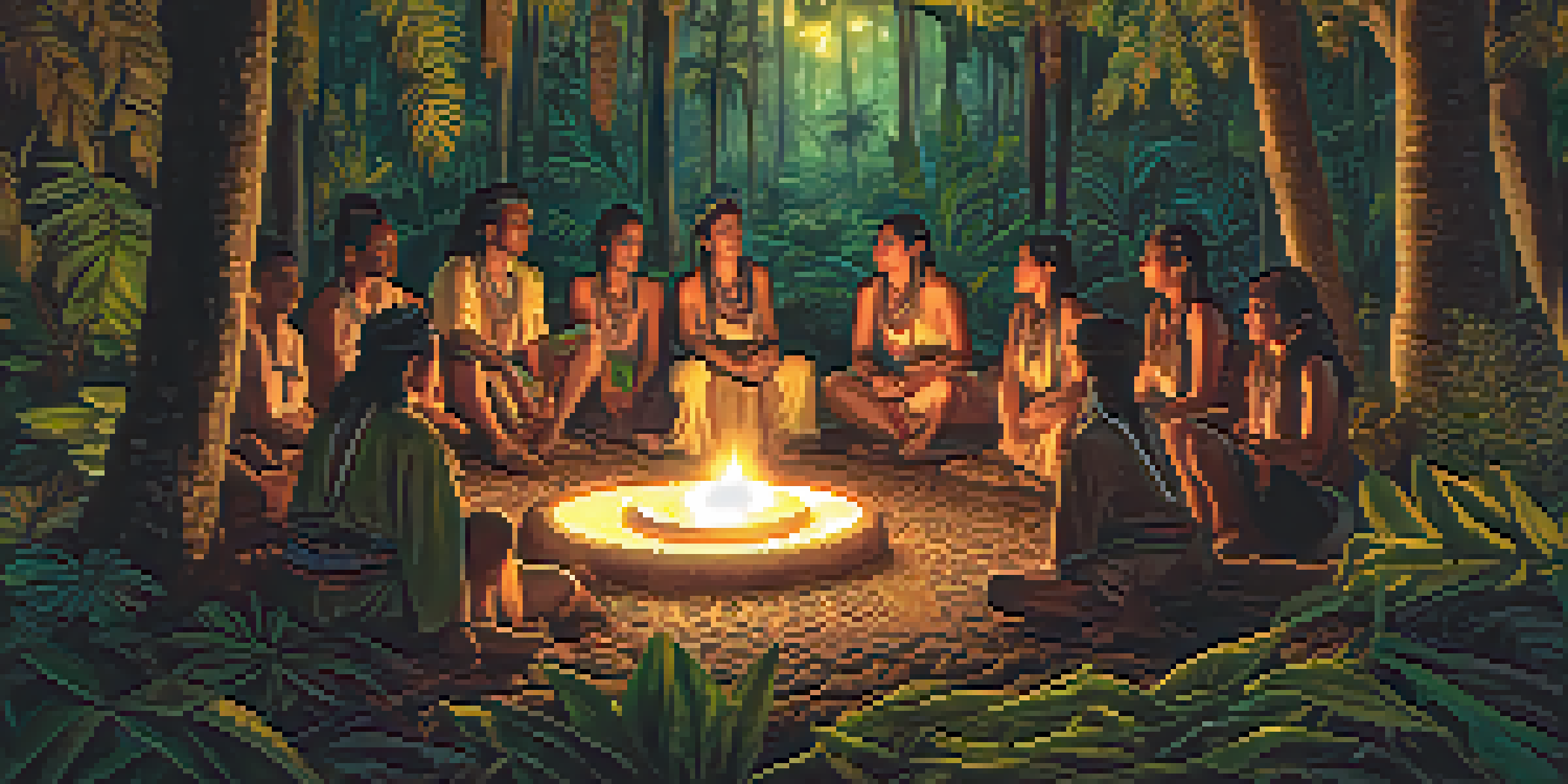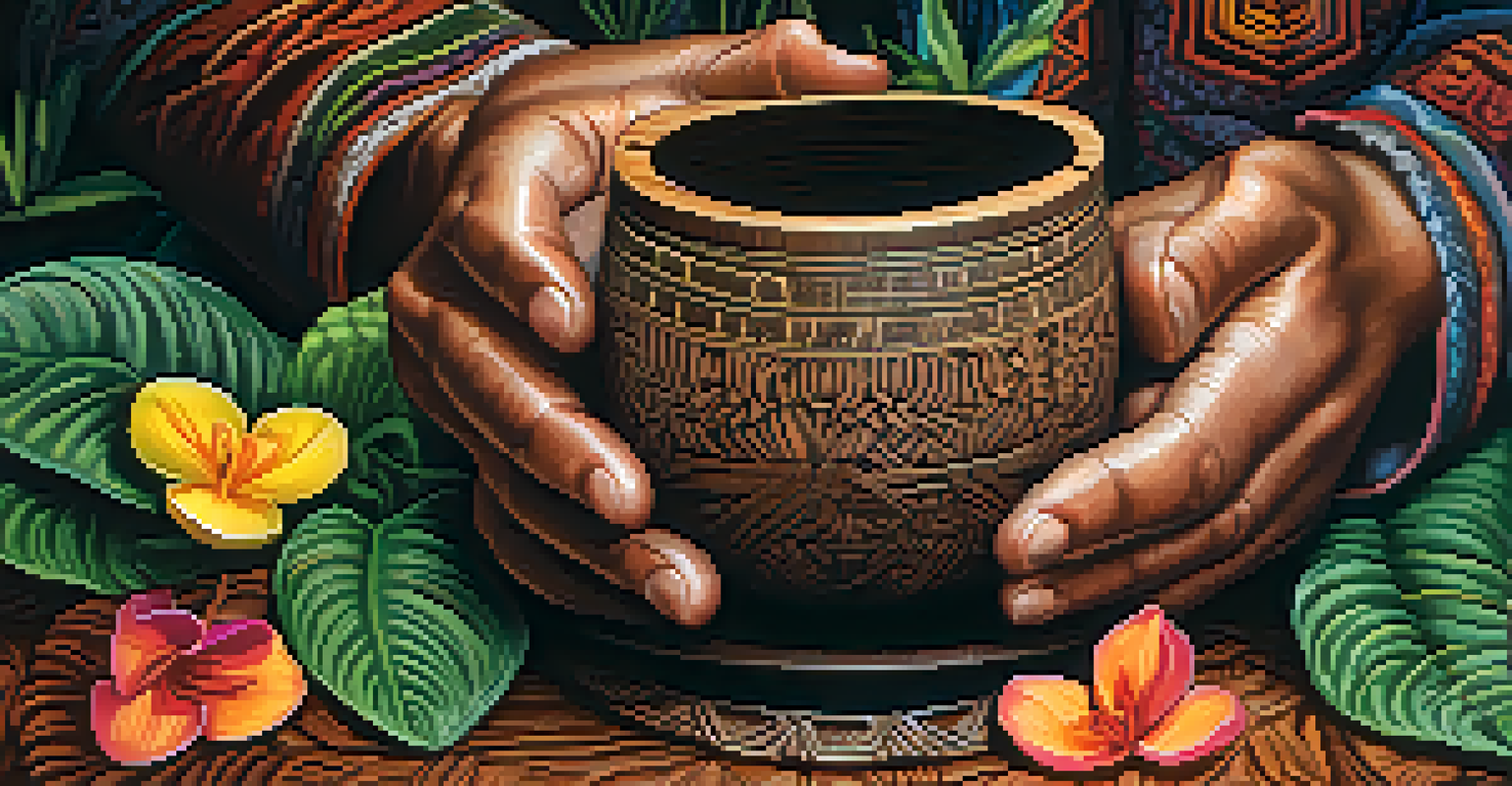Understanding the Role of Ceremony in Ayahuasca Experiences

What is Ayahuasca and Its Ceremonial Context?
Ayahuasca is a traditional Amazonian brew known for its psychoactive properties, often used in spiritual and healing ceremonies. The beverage is typically made from the Banisteriopsis caapi vine and the leaves of the Psychotria viridis plant. In many indigenous cultures, Ayahuasca is not just a drink, but a sacred tool for connecting with the spiritual world and achieving personal insights.
The plants are our teachers, and they are here to help us in our healing journey.
Ceremony plays a crucial role in the Ayahuasca experience, providing a structured environment that fosters safety and intention. This context allows participants to enter a shared space of vulnerability and openness, which can be essential for the deep emotional and psychological work that often occurs. The ceremonial setting is designed to honor both the plants and the participants, creating a respectful atmosphere.
Understanding the interplay between Ayahuasca and ceremony helps us appreciate why many people choose to participate in guided sessions rather than consuming the brew casually. The ceremonial aspects enhance the therapeutic potential of Ayahuasca, making it a transformative experience rather than just a recreational one.
Setting Intentions: The Foundation of Ceremony
One of the first steps in an Ayahuasca ceremony is setting intentions, which serve as a guiding beacon for participants throughout their journey. These intentions can range from seeking healing for emotional trauma to gaining clarity on life decisions. By articulating intentions, participants create a mental framework that primes them for the experiences to come.

The act of sharing intentions with the group fosters a sense of community and interconnectedness, reinforcing the idea that everyone is in this together. This collective energy can amplify individual experiences, as participants often find that their intentions resonate with others. The emotional support from the group can provide a comforting presence during challenging moments.
Ayahuasca as a Healing Tool
Ayahuasca is revered in Amazonian cultures as a sacred brew for spiritual connection and personal insight during ceremonial practices.
Setting intentions is not just a formal exercise; it is a deeply personal process that can significantly impact the effectiveness of the Ayahuasca experience. When participants are clear about their goals, they are more likely to engage fully with the ceremony and the insights that arise.
The Role of the Shaman in Ceremony
In many Ayahuasca ceremonies, a shaman or facilitator plays a pivotal role in guiding participants through their journeys. This individual often has extensive training and experience with the Ayahuasca brew, as well as deep cultural and spiritual knowledge. The shaman's presence provides a sense of security, helping participants navigate both the highs and lows of their experiences.
The journey of self-discovery is often the most profound when we face our deepest fears.
The shaman typically leads the ceremony with songs, known as icaros, which are believed to carry healing energies. These songs can help create a sacred atmosphere, guiding participants on their inner journeys. The shaman's role is not just to oversee the process, but to actively engage with the energies present, ensuring that the ceremony flows harmoniously.
Trusting the shaman is essential for participants, as it allows them to surrender to the experience fully. This trust is cultivated through the shaman's knowledge, presence, and the established rituals that define the ceremony, ultimately enhancing the overall experience for everyone involved.
Rituals and Practices That Enhance the Experience
Ayahuasca ceremonies often include various rituals and practices that enhance the spiritual experience. These may involve cleansing rituals, chanting, and the use of sacred objects, all designed to create a profound connection with the spiritual realm. Each ritual serves a purpose, whether it's to purify participants or to invoke protective energies.
The structured nature of these rituals helps participants to feel anchored during the often unpredictable journey of an Ayahuasca experience. By engaging in these practices, individuals can release their anxieties and focus on their internal explorations. The familiarity of rituals can also create a comforting sense of routine amid the emotional intensity that may arise.
Intentions Shape the Experience
Setting clear intentions at the beginning of the ceremony helps participants focus and enhances their emotional and spiritual journey.
Participating in these rituals allows individuals to feel part of something larger than themselves, a community bound by shared intentions and experiences. This sense of belonging can foster deeper connections between participants, making the ceremony not just a personal journey but a collective one.
Navigating Difficult Emotions During the Ceremony
Many participants in Ayahuasca ceremonies encounter challenging emotions, which can surface unexpectedly. The safe environment created by the ceremony allows people to confront these feelings head-on, often leading to significant breakthroughs. This process is an integral part of the healing journey, as it encourages individuals to face their fears and traumas directly.
Guided by the shaman and supported by fellow participants, individuals can learn to navigate these difficult emotions rather than suppress them. The communal aspect of the ceremony can provide emotional support, reminding everyone that they are not alone in their struggles. Sharing experiences can foster a sense of camaraderie, making it easier to process and integrate the emotions that arise.
While confronting difficult emotions can be daunting, many find that it leads to profound personal growth and healing. The ceremony’s structure and the presence of a supportive community make it easier to embrace these challenges, ultimately transforming them into opportunities for self-discovery.
Integration: The Aftermath of the Ceremony
Integration refers to the process of making sense of the insights gained during the Ayahuasca ceremony. After experiencing intense emotional and spiritual revelations, participants may struggle to understand how to apply these insights to their daily lives. This is where the integration phase becomes crucial, as it bridges the gap between the ceremony and real-world application.
Many facilitators encourage participants to engage in post-ceremony discussions, journaling, or therapy to help process their experiences. These practices allow individuals to reflect on their journeys, reinforcing the lessons learned and ensuring they don’t fade away. Integration helps to solidify the transformative aspects of the experience, making it a lasting part of one’s personal growth.
Integration is Key Post-Ceremony
The integration phase is crucial for participants to process their experiences and apply insights gained during the ceremony to everyday life.
Support from fellow participants is also invaluable during this phase, as sharing experiences can provide new perspectives and insights. The sense of community established during the ceremony can continue to thrive post-ceremony, offering ongoing support and encouragement as individuals navigate their integration journeys.
The Lasting Impact of Ceremony on Healing Journeys
The impact of ceremony in Ayahuasca experiences can be long-lasting, often extending far beyond the night of the ceremony itself. Many participants report profound shifts in their perspectives, relationships, and emotional well-being. This transformative potential is largely attributed to the structured, intentional nature of the ceremony, which facilitates deep healing and insight.
As participants reintegrate into their daily lives, they often find that the lessons learned during the ceremony continue to resonate. This can lead to positive changes in behavior, improved mental health, and a greater sense of purpose. The combination of personal insights and the supportive community established during the ceremony creates a strong foundation for ongoing growth.

Ultimately, the role of ceremony in Ayahuasca experiences is about creating a sacred space for healing and transformation. By honoring the traditions and practices that accompany Ayahuasca, participants can embark on a journey that not only heals but also enriches their lives in meaningful ways.